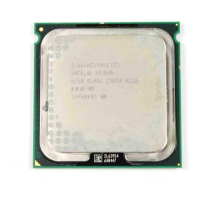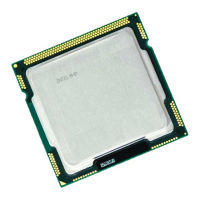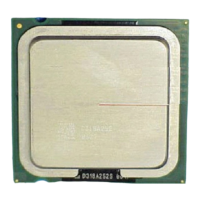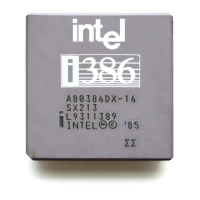Introduction
8 Dual-Core Intel® Xeon® Processor 5100 Series Thermal/Mechanical Design Guide
Note: Contact your Intel field sales representative for the latest revision and order number of this document.
1.4 Definition of Terms
Table 1-2. Terms and Descriptions (Sheet 1 of 2)
Term Description
Bypass Bypass is the area between a passive heatsink and any object that can act to form a duct. For this
example, it can be expressed as a dimension away from the outside dimension of the fins to the nearest
surface.
Digital Thermal
Sensor
Digital Thermal Sensor replaces the T
DIODE
in previous products and uses the same sensor as the
PROCHOT# sensor to indicate the on-die temperature. The temperature value represents the number of
degrees below the TCC activation temperature.
FMB Flexible Motherboard Guideline: an estimate of the maximum value of a processor specification over
certain time periods. System designers should meet the FMB values to ensure their systems are
compatible with future processor releases.
FSC Fan Speed Control
IHS Integrated Heat Spreader: a component of the processor package used to enhance the thermal
performance of the package. Component thermal solutions interface with the processor at the IHS surface.
LGA771 Socket The Dual-Core Intel
®
Xeon
®
Processor 5100 Series interface to the baseboard through this surface mount,
771 Land socket. See the LGA771 Socket Mechanical Design Guide for details regarding this socket.
P
MAX
The maximum power dissipated by a semiconductor component.
PECI A proprietary one-wire bus interface that provides a communication channel between Intel processor and
chipset components to external thermal monitoring devices, for use in fan speed control. PECI
communicates readings from the processor’s Digital Thermal Sensor. PECI replaces the thermal diode
available in previous processors.
Ψ
CA
Case-to-ambient thermal characterization parameter (psi). A measure of thermal solution performance
using total package power. Defined as (T
CASE
– T
LA
) / Total Package Power. Heat source should always be
specified for Ψ measurements.
Ψ
CS
Case-to-sink thermal characterization parameter. A measure of thermal interface material performance
using total package power. Defined as (T
CASE
– T
S
) / Total Package Power.
Ψ
SA
Sink-to-ambient thermal characterization parameter. A measure of heatsink thermal performance using
total package power. Defined as (T
S
– T
LA
) / Total Package Power.
T
CASE
The case temperature of the processor, measured at the geometric center of the topside of the IHS.
T
CASE
_
MAX
The maximum case temperature as specified in a component specification.
TCC Thermal Control Circuit: Thermal monitor uses the TCC to reduce the die temperature by using clock
modulation and/or operating frequency and input voltage adjustment when the die temperature is very
near its operating limits.
T
CONTROL
A processor unique value for use in fan speed control mechanisms. T
CONTROL
is a temperature specification
based on a temperature reading from the processor’s Digital Thermal Sensor. T
CONTROL
can be described as
a trigger point for fan speed control implementation. T
CONTROL
= -T
OFFSET
.
T
OFFSET
An offset value from the TCC activation temperature value specified in the processor EMTS or data sheet
and T
CONTROL
= -T
OFFSET
. This value is programmed into each processor during manufacturing and can be
obtained by reading the IA_32_TEMPERATURE_TARGET MSR. This is a static and a unique value. Refer to
the RS - Conroe and Woodcrest Processor Family BIOS Writer’s Guide (BWG) for further details.
TDP Thermal Design Power: Thermal solution should be designed to dissipate this target power level. TDP is not
the maximum power that the processor can dissipate.
Thermal Monitor A feature on the processor that can keep the processor’s die temperature within factory specifications
under normal operating conditions, and with a thermal solution that satisfies the processor thermal profile
specification.
Thermal Profile Line that defines case temperature specification of a processor at a given power level.
TIM Thermal Interface Material: The thermally conductive compound between the heatsink and the processor
case. This material fills the air gaps and voids, and enhances the transfer of the heat from the processor
case to the heatsink.

